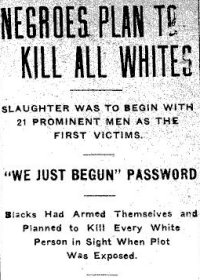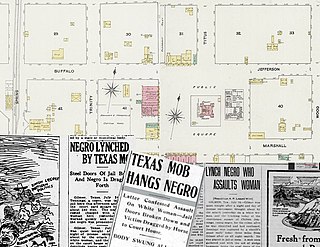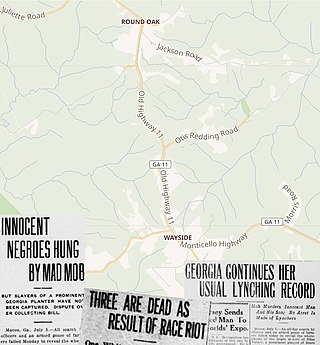Lynching
Aware of the possibility of a lynching, Sheriff Mays tried to drive Turner to Marianna, Arkansas. However, a group of masked white men stopped the sheriff, dragged Turner out of the car and shot him dead. At the same time, a separate mob stormed the jail in rear of the Phillips County Courthouse.
As the ambulance arrived on word of the shooting a larger mob of people pulled his body from the ambulance and shot his corpse several times. Then to chants from the mob of "Burn the body! Burn the body!" his body was doused with gasoline and set on fire. The Black paper, St. Louis Argus wrote, "after the celebrants had had their fill," they called the victim’s father, August Turner, to come to the little city park to and remove his son's bullet-ridden, charred remains.

The Elaine massacre occurred on September 30 – October 2, 1919, at Hoop Spur in the vicinity of Elaine in rural Phillips County, Arkansas where African Americans were organizing against peonage and abuses in tenant farming. As many as several hundred African Americans and five white men were killed. Estimates of deaths made in the immediate aftermath of the Elaine Massacre by eyewitnesses range from 50 to "more than a hundred". Walter Francis White, an NAACP attorney who visited Elaine shortly after the incident, stated "... twenty-five Negroes killed, although some place the Negro fatalities as high as one hundred". More recent estimates in the 21st century of the number of black people killed during this violence are higher than estimates provided by the eyewitnesses, and have ranged into the hundreds. The white mobs were aided by federal troops and local terrorist organizations. Gov. Brough led a contingent of 583 US soldiers from Camp Pike, with a 12-gun machine gun battalion.

Red Summer was a period in mid-1919 during which white supremacist terrorism and racial riots occurred in more than three dozen cities across the United States, and in one rural county in Arkansas. The term "Red Summer" was coined by civil rights activist and author James Weldon Johnson, who had been employed as a field secretary by the National Association for the Advancement of Colored People (NAACP) since 1916. In 1919, he organized peaceful protests against the racial violence.

Jim McMillan was lynched in Bibb County, Alabama on June 18, 1919.

Berry Washington was a 72-year-old black man who was lynched in Milan, Georgia, in 1919. He was in jail after killing a white man who was attacking two young girls. He was taken from jail and lynched by a mob.

The Jenkins County riot of 1919 took place on Sunday, April 13, 1919, a black man killed two white police officers in an altercation during a traffic stop. In response, a white mob burned several buildings in the black community and killed four black men.

The Morgan County, West Virginia race riot of 1919 was caused by big business using African-American strikebreakers against striking white workers in Morgan County, West Virginia.

The Newberry 1919 lynching attempt was the attempted lynching of Elisha Harper, Newberry, South Carolina on July 24, 1919. Harper was sent to jail for insulting a 14-year-old girl.

The Wilmington, Delaware race riot of 1919 was a violent racial riot between white and black residents of Wilmington, Delaware on November 13, 1919.

Miles Phifer and Robert Crosky were lynched in Montgomery, Alabama for allegedly assaulting a white woman.

After young African-American men volunteered to fight against the Central Powers, during World War I, many of them returned home but instead of being rewarded for their military service, they were subjected to discrimination, racism and lynchings by the citizens and the government. Labor shortages in essential industries caused a massive migration of southern African-Americans to northern cities leading to a wide-spread emergency of segregation in the north and the regeneration of the Ku Klux Klan. For many African-American veterans, as well as the majority of the African-Americans in the United States, the times which followed the war were fraught with challenges similar to those they faced overseas. Discrimination and segregation were at the forefront of everyday life, but most prevalent in schools, public revenues, and housing. Although members of different races who had fought in World War I believed that military service was a price which was worth paying in exchange for equal citizenship, this was not the case for African-Americans. The decades which followed World War I included blatant acts of racism and nationally recognized events which conveyed American society's portrayal of African-Americans as 2nd class citizens. Although the United States had just won The Great War in 1918, the national fight for equal rights was just beginning.

Paul Jones was lynched on November 2, 1919, after being accused of attacking a fifty-year-old white woman in Macon, Georgia.

African-American man, Jordan Jameson was lynched on November 11, 1919, in the town square of Magnolia, Columbia County, Arkansas. A large white mob seized Jameson after he allegedly shot the local sheriff. They tied him to a stake and burned him alive.

On Sunday, November 16, 1919, four African-Americans were lynched in Moberly, Missouri. Three were able to escape but one was shot to death.

Chilton Jennings was lynched on July 24, 1919, after being accused of attacking a white woman, Mrs. Virgie Haggard in Gilmer, Texas.

The lynching of Edward"Red" Roach was the extrajudicial killing of a 25-year-old Black man by a mob of White men in Roxboro, North Carolina for allegedly assaulting the 13-year-old daughter of popular White tobacco farmer Edward Chambers. Later, Nello Teer, Roach's employer, wrote to The Herald-Sun in Durham decrying the lynching as a “ghastly mistake” because Roach was at work when the alleged attack on Chambers occurred. No one was ever brought to justice for the lynching. A memorial service was held in Durham in remembrance of "Ed" Roach in 2019.
Owen Flemming or Flemings was an African-American man who was lynched by a mob near Mellwood, Arkansas, on June 8, 1927, after an altercation with a white man who attempted to force him to work on a levee during the Great Mississippi Flood of 1927.

Father and son Alonzo and James D. Green were innocent African-Americans lynched near Round Oak and Wayside, Jones County, Georgia in retaliation for the murder of popular white farmer Silas Hardin Turner on July 4, 1915. A third man, William Bostick was also lynched on this day. None of those killed received a trial.

On September 18, 1921, 16-year-old Eugene Daniel was lynched for walking into a white girl's bedroom.


















